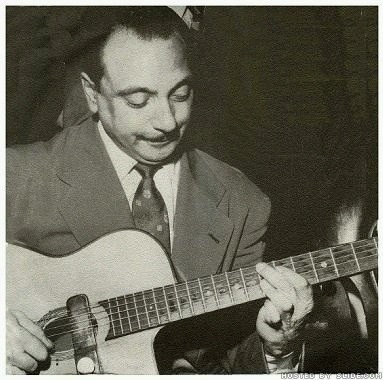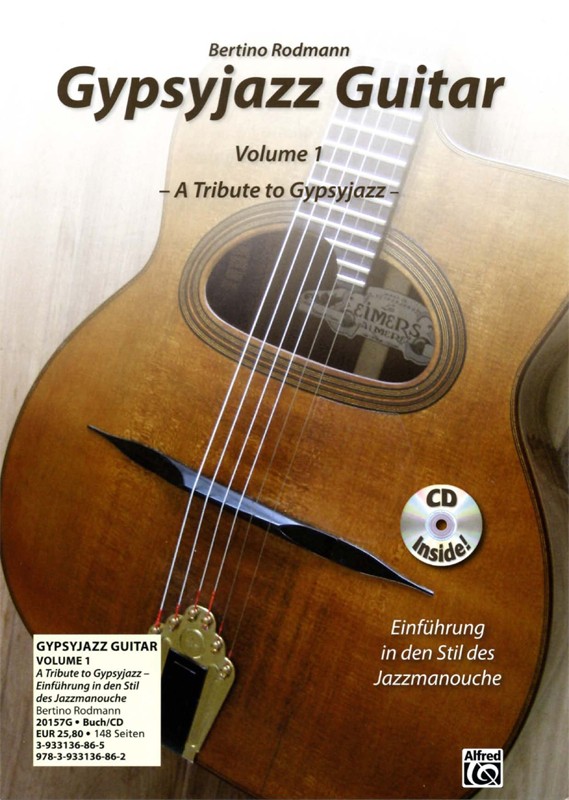eBook: JM-Chord-Lexicon

Here in our eBook “JM-Chord-Lexicon” we list the most useful Chord-Voicings and show how they are beeing used in Jazz-Manouche today. And how they supposedly might have been played by Django Reinhardt or at least how they are transmitted until today, the way he “might have” played them (who will ever know?).
The word „Chord“ is utilized for a bunch of notes that are played all together on any instrument. Most of the time these are so called „major or minor triads“, a rootnote plus third and perfect fifth of any kind of scale, that sound together, on the guitar often with additionally added octavs. In Jazz most of the time there are chords out of 4, 5 or even 6 notes beeing utiized, often with additional 6st, 9th or 13th notes. These are the so called „extended chords“.


As mentioned in my articles on JM-playtechnique and also in my book „Gypsyjazz Guitar“, chords that are uitilized in Jazz-Manouche are heavily influenced by the playtechniques of guitar-maestro Django Reinhardt.

Many of the chords are not beeing played in a normally used manner (for example as so called “barré”-chords) but nevertheless beeing played in Django´s style of playing voicings in Jazz-Manouche.
These voicings are special ways of playing his own chordvoicings that were originally developed by Django. And which have later on been copied (also in the USA) by many Jazzguitarrists like for example Charlie Christian and others and thus by that found their appereance in today´s Jazzplaying. These voicings are still beeing used in Jazz-Manouche today.
Some things in these voicings are very uncommon and the interested guitarrist has to overcome some used habits to be able to play really authentic GJ-Chords in many situations.
One example is the E7th-chord with added 9th beeing played as E9, which will be played most of the time together with E and B – so basically it is still a normal E7/9th-Chord (image left), but with an added fifth (B) in Bass. Also the Standard E7-chord is played with added B on the deep E-string…

The Idea behind that is that Rhythmguitarplayers in Gypsy-Jazz would rather play bass-oriented (sometimes just because of lack of bassplayers) … but also because the high registers in a traditional Gypsybands normally are reserved for the Soloists (Violin, Guitar, Brass).
Thru that fact a clear distinguishing of low notes (Rhythm) and high notes (Solo) is possible. But this may just appear as another sideeffect resulting from Djangos playing, which still has been copied ever since by his legacy and abroad
Django Reinhardt couldn´t no more play „normal“ Barré-chords so he developed his own ways of playing 3-Finger-Chords (image top left), which are often reduced three-note-chords with root, third, fifth or additional sixt and ninth. So THESE kind of chords have especiqlly been copied by the early Jazzmen like Charlie Christian and others and found their way into Jazz by that beeing again copied and used by Jazzpianists and other Jazzmusicians later on.

One can tell that clearly by listening to old jazz-records. In the beginning like early 1930ies there were no such things like E9th or Minor 6-chords, as these were just beeing invented by Django on Jazzguitar at that time.
Regrettably even today Django Reinhardt´s influence on Jazz and guitarplaying in general on todays guitar-techniques is still totally neglected in many books and teaching-materials!
Until mid 1940ies (when Django started playing Bebop-influenced Jazz) most of the Jazztunes coming to europe from USA were beeing played with Dominant7- or Minor7th-Chords (often utilized as barrés).
This initially was changed on the guitar with european (Gypsy-)Jazz by Django and his legacy and this is also one of the main differences between Mainstream-Jazz and Jazz-Manouche. In Gypsyjazz most of the time Dominant-6st or Minor-6st-chords are beeing subsituted for any usual Dominant- or minor7th-chords by most Gypsyplayers, according to his legacy.

Here in our JazzManouche-Chord-Lexicon we list up the mostly utilized chords which usually are beeing played in Jazz-Manouche. Of course there are so many different ways of playing chords that there is no claim of completeness in this list. For any Jazz-Guitarrist its crucial to know as many chords as possible and know how to play them, to create interesting and tasty lines of changes to back up the soloist.
For your convenience the chords are grouped into certain categories of Dominant-, minor- and special-chords:
Contents JM-Chord-Lexicon
- Dominant7 – Chords
- Dominant7 – extended Chords
- Dominant6 – Chords
- Dominant6/9 – Chords
Minor
- Minor 7 – Chords
- Minor 7 – extended Chords
- Minor 6 – Chords
- Minor 9 – Chords
Specials
- Disminished – Chords
- Special Chords
(You will be redirected to our external Shopsite www.gypsyjazzworkshop.net)

ADVERTISING
 “Gypsyjazz Guitar – a tribute to Gypsyjazz“
“Gypsyjazz Guitar – a tribute to Gypsyjazz“
Gypsy-Jazz bzw. Jazz-Manouche ist der erste in Europa entstandene Jazzstil.
Seine Einflüsse kommen aus dem französischen Musette-Walzer, dem ungarischen Çsardas oder dem spanischen Flamenco, sowie der Sinti-Musik selbst, die von den Sinti-Musikern in Swing-Phrasierung interpretiert wurde.
Ziel des Buches: Nicht nur eine umfassende Gitarrenschule für Gypsy-Jazz Gitarre zu verfassen, die die rhythmischen und solistischen Aspekte der Gypsyjazz Gitarren-Spielweise vermittelt, sondern auch den Respekt gegenüber der uralten Tradition der Sinti.
Inhalt Teil 1: Rhythm Guitar: Comping, La Pompe-Rhythmus, Dead Notes, Gypsychords, Voicings, Blues-Kadenz, Chord Substitution
Inhalt Teil 2: Solo Guitar: Reststroke Picking, Arpeggio Picking, Sweptstroke Picking, Skalen, Arpeggien, Solo Licks
Verlag: Alfred Music Publishing GmbH; Auflage: 1 (15. Oktober 2011)
Sprachen: Deutsch / English ISBN-10: 3933136865 – ISBN-13: 978-3933136862
148 Seiten, mit Play-alongs und Noten & Tabulatur + Audio-CD Preis: 25,80
Erhältlich bei Amazon, Alfred Verlag oder www.bertino-guitarrist.com
Share this article:

